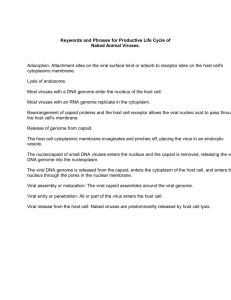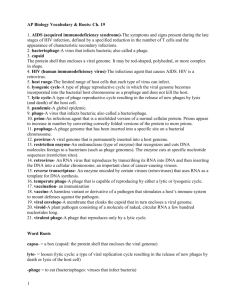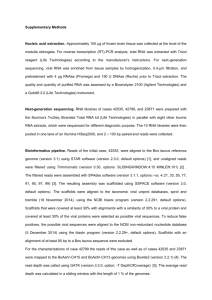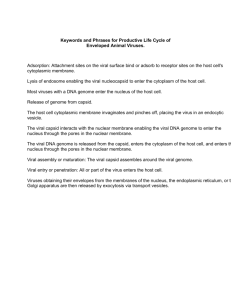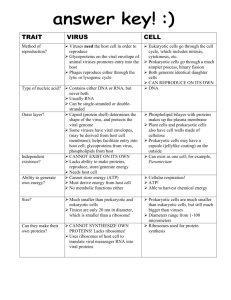REPLICATION:
advertisement
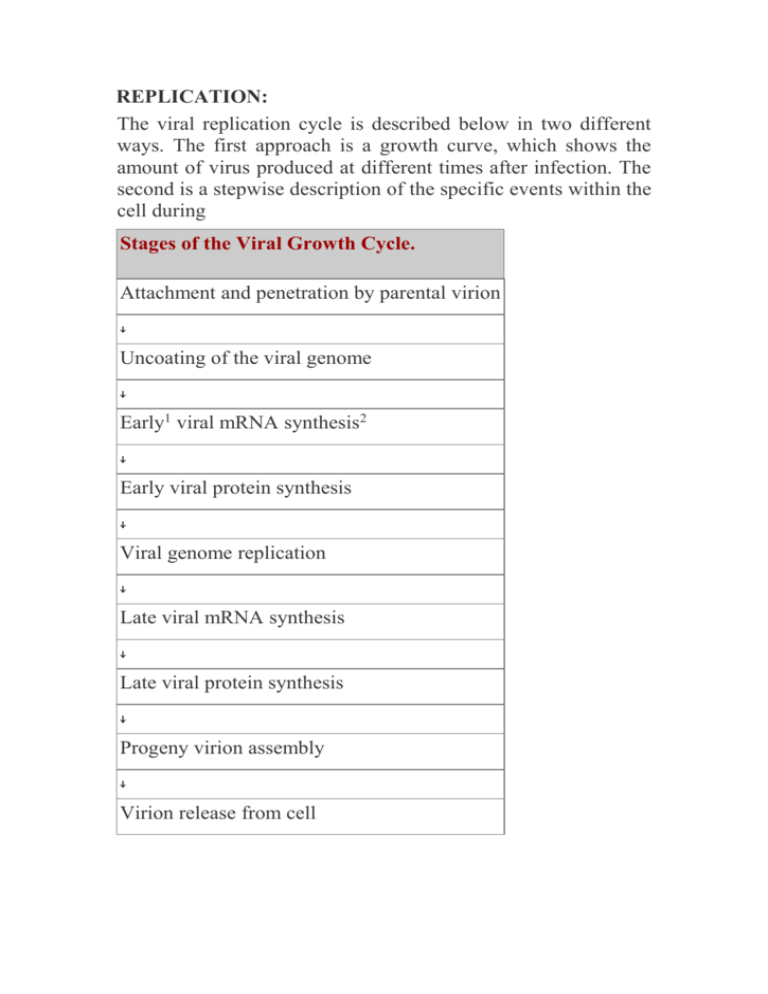
REPLICATION: The viral replication cycle is described below in two different ways. The first approach is a growth curve, which shows the amount of virus produced at different times after infection. The second is a stepwise description of the specific events within the cell during Stages of the Viral Growth Cycle. Attachment and penetration by parental virion Uncoating of the viral genome Early1 viral mRNA synthesis2 Early viral protein synthesis Viral genome replication Late viral mRNA synthesis Late viral protein synthesis Progeny virion assembly Virion release from cell Viral Growth Curve One virion infects a cell and hundreds of progeny virions are produced within hours. This is a remarkable amplification and explains the rapid spread of virus from cell to cell. The eclipse period is the time when no virus particles are detected within the infected cell. It occurs soon after the cell is infected. Cytopathic effect (CPE) is the term used to describe the damage, both morphologic and functional, inflicted on the cell by the virus. In the clinical laboratory, the presence of a virus in the patient's specimen is often detected by seeing a CPE in cell culture. Viral Growth Cycle Attachment: The interaction of proteins on the surface of the virus with specific receptor proteins on the surface of the cell is one of the main determinants of both the species specificity and the organ specificity of the virus. Infectious nucleic acid is viral genome DNA or RNA, purified free of all proteins, that can undergo the entire replicative cycle within a cell and produce infectious progeny viruses. Infectious nucleic acid, because it has no associated protein, can enter and replicate within cells that the intact virion cannot. Polarity of Viral Genome RNA: Genome RNA that has the same base sequence as the mRNA is, by definition, positive-polarity RNA. Most positive-polarity genomes are translated into viral proteins without the need for a polymerase in the virion. The exception is the retroviruses, which use reverse transcriptase in the virion to transcribe the genome RNA into DNA. Genome RNA that has a base sequence complementary to mRNA has, by definition, negative polarity. A virus with a negative-polarity RNA genome must have an RNA polymerase in the virion to synthesize its mRNA. Viral Gene Expression: All viruses require virusspecific messenger RNA to synthesize virus-specific proteins. RNA Viruses: Some RNA viruses, such as poliovirus, have a positive-polarity RNA genome that serves as the mRNA, i.e., the genome is the mRNA. Other viruses, such as influenza virus, have a negative-polarity RNA genome and have an RNA polymerase in the virion that synthesizes the viral mRNA. Rotavirus has a doublestranded RNA genome and has an RNA polymerase in the virion that synthesizes the viral mRNA. Retroviruses, such as HIV, have a positive-polarity RNA genome and have a DNA polymerase in the virion that synthesizes a DNA copy of the RNA genome. This DNA is the template used by the host cell RNA polymerase to synthesize the viral mRNA. DNA Viruses: Most DNA viruses, such as herpesviruses, adenoviruses, and papillomaviruses, have a double-stranded DNA genome and use the host cell RNA polymerase to synthesize the viral mRNA. Poxviruses have a double-stranded DNA genome but have an RNA polymerase in the virion that synthesizes the viral mRNA. Poxviruses have an RNA polymerase in the virion because they replicate in the cytoplasm and do not have access to the host cell RNA polymerase in the nucleus. Viral Replication: All DNA viruses replicate in the nucleus, except poxviruses, which replicate in the cytoplasm. All RNA viruses replicate in the cytoplasm, except retroviruses, influenza virus, and hepatitis D virus, which require an intranuclear step in their replication. Many viruses encode a replicase, which is a DNA or RNA polymerase that synthesizes the many copies of the progeny viral genomes. Viral Genome: The genome of all DNA viruses is double-stranded except for that of parvoviruses, which is single-stranded. The genome of all RNA viruses is single-stranded except for that of reoviruses, e.g., rotavirus, which is double-stranded. Viral Proteins: Early proteins are typically enzymes used in the synthesis of viral components, whereas late proteins are typically structural proteins of the progeny viruses. Some viruses, such as poliovirus and retroviruses, translate their mRNA into precursor polyproteins, which must be cleaved by proteases to produce functional proteins. Assembly and Release: All enveloped viruses acquire their envelope by budding through the external cell membrane as they exit the cell, except herpesviruses, which acquire their envelope by budding through the nuclear membrane. The matrix protein mediates the interaction of the nucleocapsid with the envelope. Lysogeny is the process by which viral DNA becomes integrated into host cell DNA, replication stops, and no progeny virus is made. Later, if DNA is damaged by, for example, UV light, viral DNA is excised from the host cell DNA and progeny viruses are made. The integrated viral DNA is called a prophage. Bacterial cells carrying a prophage can acquire new traits, such as the ability to produce exotoxins such as diphtheria toxin. Transduction is the process by which viruses carry genes from one cell to another. Lysogenic conversion is the term used to indicate that the cell has acquired a new trait as a result of the integrated prophage

